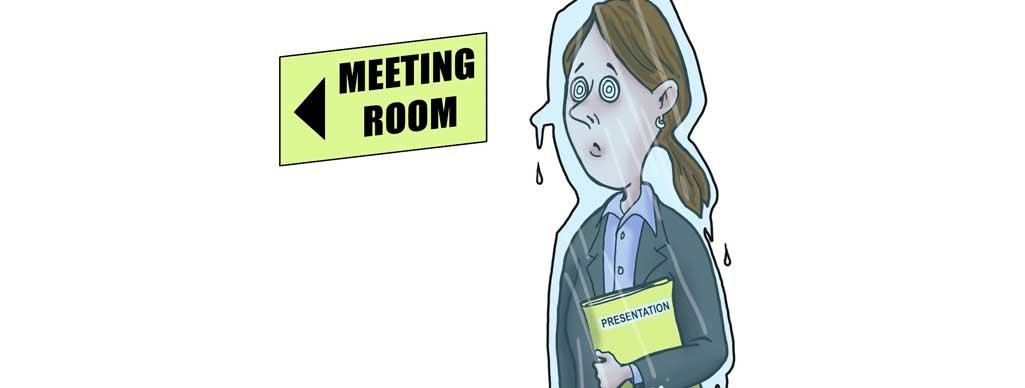
Vartika Dutta, IIM Amritsar
vartika.dutta@iimamritsar.ac.in

Just 10 minutes before a crucial meeting, has it ever happened to you that your mind has become completely fogged and you are getting cold feet even to step out of your cubicle to enter the main meeting room or in the virtual meeting to press the button “Join Now?”
Well, if you are honestly reflecting upon the scenario mentioned above, all of us, in our careers, would have had such testing moments. It’s during moments like these that you could feel that your confidence has suddenly evaporated and that you should just skip this meeting. The origin of this behaviour could be a provocative response by a supervisor, a jealous co-worker, or a disdainful subordinate, and the brain might interpret all of these individuals and their predicted response as a threat to your survival.
The fight-or-flight reaction is triggered by the amygdala, the brain’s alarm clock, which hijacks the control centre within the brain. This knee-jerk reaction without any reflection proves that the brain is paralyzed to think and act. When we need heightened concentration to take the final call, we lose any rational perspective around such issues. This acute stress response is a physiological and psychological response of our body. This circuit in our brains, to react to any danger or threat, gets heightened and ultimately hinders the analytical and strategic thinking required in the workplace.
Psychological Safety-The new mantra for Effective Teams
Researchers studying trustworthy workplaces have found that the primary reason behind these feelings and subsequent behaviors displayed by employees is psychological safety. According to research, psychological safety allows for a shared feeling and a fearless attitude to be candid while making a point by not trying to cover up one’s tracks to avoid being embarrassed or pushed aside. The actual act of raising creative ideas and suggestions without the fear of getting punished thereby encourages/promotes a culture where mistakes are encouraged and celebrated. These are the essential ingredients to create effective and High-Performance Work Teams within the organizations.
The glue that binds employees together in an organization is Interpersonal trust. It refers to our beliefs in the competence of another person, particularly relevant in achieving a particular goal and knowing about the benevolence of the individual that they would never have any ulterior motives. As managers, we need to earn employees’ trust before they feel comfortable engaging in any meeting. The business idea’s success might entirely depend on a crucial meeting where all stakeholders come together to discuss the various business outcomes. Trust and psychological safety in teams can help our employees create pooled connections, build resilience and tenacity, and enhance motivation. These are all abilities they’ll need to succeed in their careers.
According to old evolutionary adaptations, psychological safety is fragile yet critical for any high-performance work situation involving interdependence. Google’s Head of Industry, Paul Santagata, explains, “Without trust, there is no team.” He’s mindful of the results of Google’s two-year-long Project Aristotle on successful team performance, which concluded that the most effective high-performing teams have one trait: psychological safety, or the belief that mistakes will not result in a penalty. “In Google’s fast-paced, high-demand work culture, our ability to effectively communicate is a critical component of our success,” Santagata says.
According to Barbara Fredrickson of North Carolina, positive emotions like empathy, interpersonal trust, curiosity, and motivation help us build cognitive, emotional, social, and physical resources. We become more open-minded, adaptable, focused, and determined when valued. Humour, creativity, critical thinking, and problem-solving abilities are all on the upswing. The work setting looks demanding but not frightening, which helps teams retain a trusting atmosphere. More oxytocin gets produced in our brains, which increases trust and trust-building competencies.
Workers are constantly deterred from participating in the meetings due to fear of being wrong or ridiculed. Our role as managers is to help employees overcome their psychological and social barriers in establishing a safe environment to strive to reach their maximum potential. We build trust among people in this way, which has been demonstrated to improve relationships, drive engagement, enhance creativity and performance, and make people feel included and respected.
How can Leaders Foster Psychological Safety in Teams
So, what pointers can we keep in mind to promote psychological safety within teams to build more trustworthy behaviors within employees?
1. Make psychological safety a top priority- This has to start from building a workplace which begins with the feeling of belongingness. It appreciates and welcomes demographic diversity and cognitive and experiential diversity while creating teams. To make the “cake mix” like diversity characteristics work, there has to be a strong impetus on inclusive policies and processes that keep in mind the varied needs of its employees and give everyone an equal and fair chance to express and contribute towards the smooth functioning of the organization. Model the behaviors you wish to see in the workplace and set the tone by demonstrating empathy.
2. Encourage everyone to speak up- A culture where a free flow of ideas is welcomed and transparency and truth are encouraged by demonstrating curiosity. When someone says something that challenges the status quo, be open-minded, sympathetic, and sensitive. Team members with the guts to speak truth are more likely to be present in workplaces with a coaching culture. Recognizing the fundamental needs of respect, competence, social status and autonomy inspires trust and encourages constructive language and conduct.
3. Establish procedures for dealing with failure- There should be no room left for penalizing any experimentation within acceptable limits of risks. Encourage people to learn from their failures and setbacks, and share your lessons earned from the mistakes made with others. This culture of open inquiry will foster innovation and creativity within teams. Prepare for possible reactions before engaging in difficult conversations.
4. Make room for fresh ideas- Provide the challenge within a bigger context of support when challenging a concept. Consider whether you only want concrete, mature ideas which have been tested entirely or you are willing to try out some half-baked but out-of-the-box ideas as well. To create more innovative mindsets in your team, learn to embrace fresh ideas.
5. Positively embrace disagreements- Encourage productive discourse and debate, and seek to resolve disagreements effectively. Leaders can propel organizations towards business transformation by defining team expectations for variables that contribute to psychological safety.
How can Team Members encourage Psychological safety?
To encourage good dialogue and debate, team members can take the following steps:
To understand sentiments, beliefs, and facts, ask forceful, open-ended questions and then listen actively and closely.
Recognize that mistakes are an opportunity to learn and improve, and agree to share failures.
Whether you’re expressing gratitude or dissatisfaction, be open and honest.
When requested for assistance, ask for it and readily provide it.
Rather than a single “hero,” embrace the knowledge of many.
Encourage and show thankfulness, which helps team members to feel more self-assured.
By including psychological safety as a part of every intervention, an organization can get a pulse of security, mutual trust and respect, and other nuances of team dynamics. Fostering psychological safety will lead to higher engagement levels, increased drive to handle complex issues, and more learning and growth initiatives championed by the employees, thereby creating productive and high-performance teams. This is the much-needed ingredient to focus on while designing interventions to develop and sustain effective and happier teams.
Posted in Health & Wellbeing | No Comments »
Recent Articles
- Navigating Leaves: Balancing Connectivity and Breaks in Today’s Workplace
- Boost Your Productivity with the Pomodoro Technique
- The Busy Professional’s Guide to Self Care
- Mental Health @ Work
- Mental Health and Well-being
- Positivity: Why you should make a New Year’s Resolution
- Get To Know About Nomophobia
- Fuelling Health: Energy of Our Body
- Keep Running
- Is Living Alone a Curse or a Boon? No, It is an Art
- Living with Meaning: Workplace Spirituality, Mindfulness, and Purpose
- Delivering Happiness during Pandemic
- HUMRAHEE: We are in This Together
- CHETNA: Personal Connect during COVID 19
- Ecosystem Restoration @ BPCL
- Leading the Way: HR Initiatives during Pandemic
- Living with the Invisibile
- Resurrection
- Health and wellness- From benefits to necessity
- Personal Strategies to Improve Well-being-CALM ki baaten
- Sustainability as Competitive Advantage
- Cold Feet Before the Meeting! Does it Sound Familiar
- 9 Common Workout myths debunked
- Positive Psychology – Mantra of Well-being
- Human Resource Development Through Sports At Workplace
- Nature Heals_How to boost your brain power with nature
- Success Story of Waste Segregation
- Occupational Health & Safety Bulletin on : Managing MSDs (Musculoskeletal Disorder)
- Gratitude: The Game Changer Antidote to All The Dis-eases
- Effective Time Management
- Watch out and act now Prioritizing Mental Health at Work
- Pursuing a Passion Outside of Work for mental wellness
- Prioritizing Mental Health at Work
- Health or Help – what will you prioritize?
- Digital Wellbeing – Way towards Mental Health
- Love yourself the way you want others to
- Kissa Kursi Ka
- Atychiphobia: Understanding the fear of failure
- Is Yoga = Meditation? Let’s solve it
- Overcoming Failure
- From Surviving to Thriving: Building a Culture of Employee Well-being
- Solid Waste Management -A dire necessity
- Sleep health: The cornerstone of Wellbeing
- Miracle of Stress
- Health & Wellbeing in the Organization
